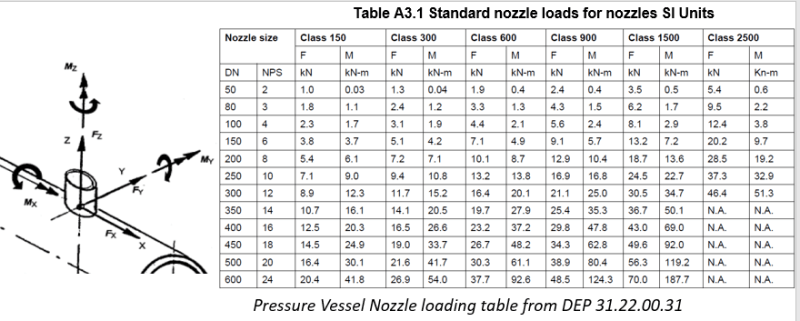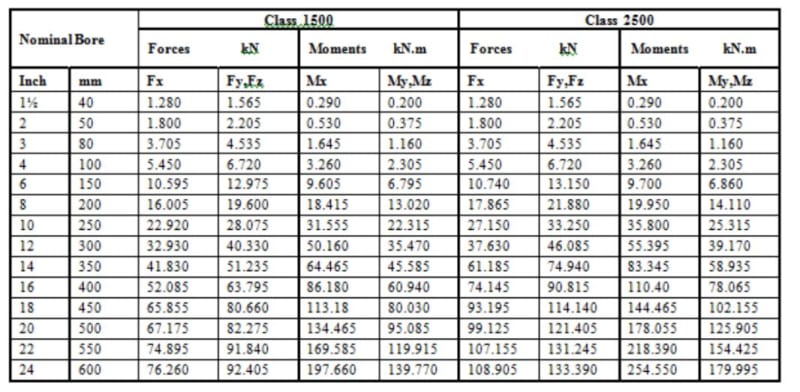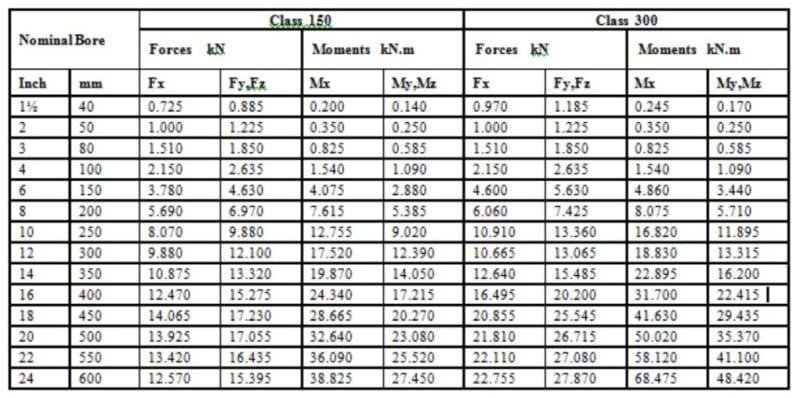Navigation
Install the app
How to install the app on iOS
Follow along with the video below to see how to install our site as a web app on your home screen.
Note: This feature may not be available in some browsers.
More options
Style variation
-
Congratulations TugboatEng on being selected by the Eng-Tips community for having the most helpful posts in the forums last week. Way to Go!
You are using an out of date browser. It may not display this or other websites correctly.
You should upgrade or use an alternative browser.
You should upgrade or use an alternative browser.
Nozzle Load Calculations 2
- Thread starter SmallInfo
- Start date
- Status
- Not open for further replies.
"does anyone know which spec of unfired pressure vessel got this table of nozzle loads?"
None of them ...Not ASME VIII or EN or BS
You say that you found a "pressure vessel spec online.. Which PV codes or Standards were referenced in that specification ?
MJCronin
Sr. Process Engineer
None of them ...Not ASME VIII or EN or BS
You say that you found a "pressure vessel spec online.. Which PV codes or Standards were referenced in that specification ?
MJCronin
Sr. Process Engineer
- Thread starter
- #3
Such tables are prepared typically by the Contractors or Client since actual piping design and loading will come much later than vessel fabrication.
Having that table allows the vessel designer to design the nozzle ahead of piping routing and flexibility analysis.
Piping designer will then have to adjust their design to not exceed that loading values on the tie-in with the vessel nozzle.
Each Contractor/Client have different values on that nozzle loading table depending on their experience and design basis.
Having that table allows the vessel designer to design the nozzle ahead of piping routing and flexibility analysis.
Piping designer will then have to adjust their design to not exceed that loading values on the tie-in with the vessel nozzle.
Each Contractor/Client have different values on that nozzle loading table depending on their experience and design basis.
- Thread starter
- #7
Pavel_1976
Mechanical
Look in DEP 31.22.00.31 for some allowable data for nozzle. Although API610 for pumps nozzles. But all of these are common practices of certain company.
Generally this values are really low in due to no one made detailed analysis of these nozzles. And there are some difference for which device this nozzle connected (for pump, heat exchanger and vessel).
And I have a question about combination (utilization) of several loads at the same time.
Sometimes really low allowable load means that if all applied loads are below any corresponded allowable value that means that design is accepted. But sometimes we should obtain common utilization factor (like Fx/Fxallow+Fy/Fyallow+Fz/Fzallow+Mx/Mxallow+My/Myallow+Mz/Mzallow<=1).
The API610 has more sophisticated rules for combination method.
Does anybody have a point of view for common practise of this approach? Because sometimes it is not clear in a vender documentation.

Generally this values are really low in due to no one made detailed analysis of these nozzles. And there are some difference for which device this nozzle connected (for pump, heat exchanger and vessel).
And I have a question about combination (utilization) of several loads at the same time.
Sometimes really low allowable load means that if all applied loads are below any corresponded allowable value that means that design is accepted. But sometimes we should obtain common utilization factor (like Fx/Fxallow+Fy/Fyallow+Fz/Fzallow+Mx/Mxallow+My/Myallow+Mz/Mzallow<=1).
The API610 has more sophisticated rules for combination method.
Does anybody have a point of view for common practise of this approach? Because sometimes it is not clear in a vender documentation.

I would agree that it's a table developed by a customer/client. You don't know the assumptions behind the table so it's not worth a lot other than a high level sanity check.
This article features a similar type table.
Caesar II pipe stress software includes a set of nozzle loads taken from "Consideration of Nozzle Loads on Vessels in Process Plants", Ausgabe, 2007.
This article features a similar type table.
Caesar II pipe stress software includes a set of nozzle loads taken from "Consideration of Nozzle Loads on Vessels in Process Plants", Ausgabe, 2007.
-
2
- #10
@Pavel_1976, the DEP states those are acting simultaneously in the notes. For other Clients as well that is understood to be acting simultaneously and you can change it to the resultant value for nozzles on spheres or ellipsoidal heads.
API 660~663 as well provide nozzle loading tables, but those are sometimes overridden by the Client/Contractor specification.
Those tables were established before UG-44(b) was introduced and some nozzles would automatically have to increase flange rating just to pass with those table values for local stress and UG-44(b) on the flange.
API 660~663 as well provide nozzle loading tables, but those are sometimes overridden by the Client/Contractor specification.
Those tables were established before UG-44(b) was introduced and some nozzles would automatically have to increase flange rating just to pass with those table values for local stress and UG-44(b) on the flange.
- Status
- Not open for further replies.
Similar threads
- Replies
- 14
- Views
- 15K
- Replies
- 0
- Views
- 966
- Replies
- 2
- Views
- 11K
- Replies
- 7
- Views
- 11K
- Replies
- 0
- Views
- 920


